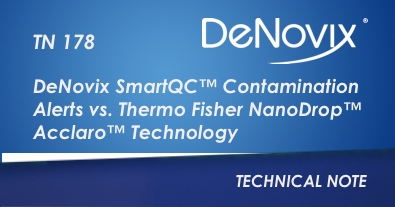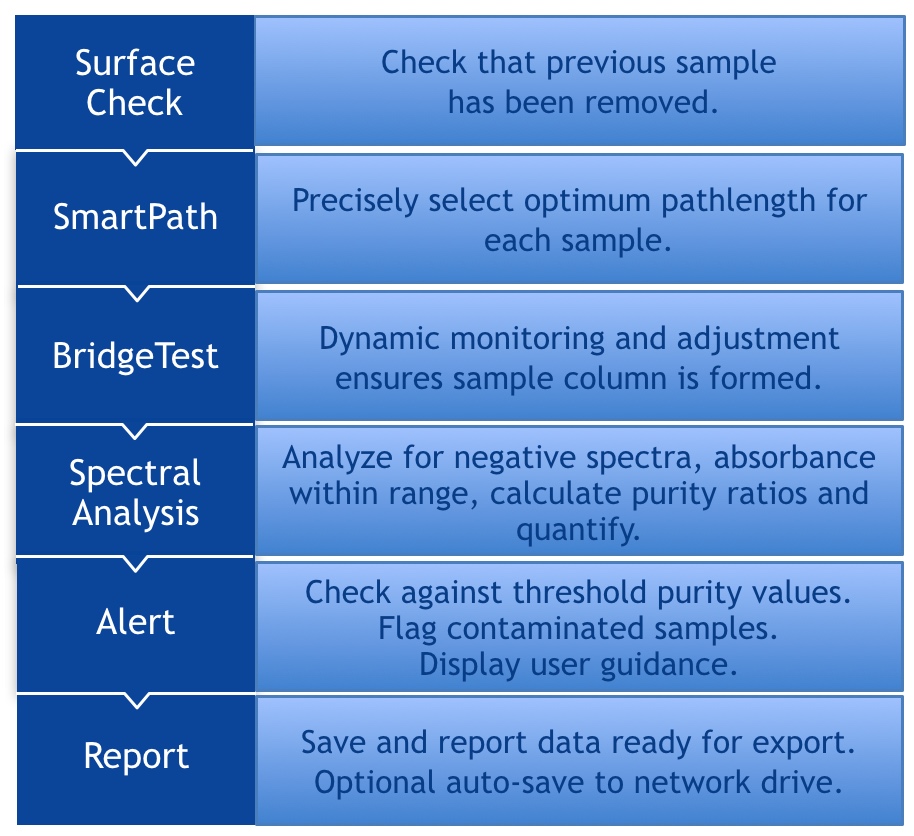Introduction
This document highlights the value of DeNovix SmartQC™ contamination alerts found on DeNovix DS-11 Series instruments and explains how it oversees the entire sample measurement process. Multiple algorithms ensure confidence in results while simultaneously providing important information to scientists about possible sample anomalies. This note also compares SmartQC to Acclaro™ technology of the Thermo Fisher Scientific NanoDrop™ One spectrophotometer.
Total Sample Confidence
Identifying co-extracted contaminants and having confidence in the quality control process is of great value in determining the suitability of a sample for downstream applications. SmartQC is a unique suite of software features that alerts users to potential sample contaminants and helps to avoid common sample measurements errors (figure 1).
SmartQC Contamination Alerts Key Features
Contamination Alerts
Using visual alert icons, SmartQC clearly flags samples that do not meet well-established purity specifications. Tapping on an alert icon on the Run screen will provide detailed information regarding the possible reasons for the high or low value.
For nucleic acids, common contaminants such as phenol, protein, carbohydrates, guanidine and glycogen are identified by SmartQC. For proteins, the presence of nucleic acids or buffers that absorb highly in the UV range are typical factors affecting purity measurements.
SmartQC Custom Limits
One important element of SmartQC contamination alerts is the use of defined thresholds for the robust method of purity ratio determination.
To ensure that each investigator or lab identifies samples that meet the criteria specific to their studies, DeNovix software enables users to define and save custom limits or use well-established default values. Users may also choose to not enforce any limits. This flexibility allows full compliance to laboratory and protocol standards across all users.
The Thermo Fisher NanoDrop™ Acclaro™ technology also uses a purity ratio alert feature. However, that software does not offer the option to customize or turn off the limits.
The Thermo Fisher Acclaro™ technology presents only one icon on the screen, whereas DeNovix SmartQC presents separate icons for each nucleic acid ratio, making it immediately clear which ratio is out of specification. To add to possible confusion, the Thermo Fisher Acclaro™ technology ratio alert information icon is sometimes—but not always—used in conjunction with a deconvolution icon.
Deconvolution vs. Contamination Alerts
The Thermo Fisher NanoDrop™ Acclaro™ technology includes a deconvolution feature that attempts to present corrected concentration values for samples with significant contaminant levels. In the case of nucleic acids contaminated with protein, the sample needs to be grossly contaminated with 75% or more protein (<25% nucleic acid) for the deconvolution to be enabled. In addition, the deconvolution feature is only applied to samples within a limited dynamic range (25 to 3125 ng/μL). DeNovix SmartQC focuses on notifying users when samples do not meet user-defined criteria, ensuring measurement integrity and enabling the user to make informed decisions.
SmartPath™ Technology with Bridge Testing™ Verification
The Thermo Fisher NanoDrop™ One spectrophotometer user guide indicates that the accuracy of the deconvolution algorithm instrument is dependent on whether the instrument’s maintenance schedule is followed. DeNovix SmartPath™ technology, a unique innovation at the heart of the DS-11 Series, eliminates the need for instrument recalibration and scheduled maintenance procedures. Scientists can have high confidence that every trial performed by a DeNovix instrument provides accurate results.
In addition to identifying potential contamination, SmartQC contamination alerts diagnose methodological errors that can result in inaccurate absorbance measurements. The software monitors the sample measurement and cleaning process and warns users when a sample has not been removed by a previous user.
DeNovix’s SmartPath technology also includes patented Bridge Testing™ verification. Bridge Testing detects if a sample is not bridging the optical surfaces and automatically compensates to provide a correct measurement in real time. The Thermo Fisher NanoDrop™ One spectrophotometer may alert the user to a sample column anomaly, but it is not capable of making an adjustment to complete the column and will not report a measurement result. The user must reload and use extra sample.
Co-Extracted Nucleic Acids: The Importance of Fluorescence
Nucleic acids, when co-extracted with the molecule of interest (e.g., fragmented DNA, oligo, RNA in a dsDNA prep), cannot be distinguished reliably through measuring absorbance alone. Since all nucleic acid species absorb maximally at 260nm, measuring by only using absorbance could result in an overestimation of sample concentration.
For samples containing contaminants or buffers that interfere with the measurement wavelength in use, fluorescence quantitation—using fluorophores specific for the molecule of interest—is the ideal complimentary method to absorbance quantitation.
The DS-11 Series Spectrophotometer / Fluorometer and FX Module enable both absorbance and fluorescence measurements in one instrument. The combination of absorbance and fluorescence provides greater confidence and accuracy when measuring samples and is a protocol requirement in applications such as Next Generation Sequencing.
Summary
DeNovix SmartQC contamination alerts monitor the complete measurement and quality control process and notify users of potential sample contamination in real time. Onscreen alert icons and specific guidance messages provide valuable insights for troubleshooting nucleic acid and protein extractions.
DeNovix instruments, combining innovative software with complimentary absorbance and fluorescence capabilities, deliver unparalleled sample insight. DeNovix enables today’s scientists to make informed decisions when using samples in expensive or time-consuming downstream applications.
Comparison of DeNovix software v 3.17 vs. NanoDrop™ One v 1.14 October 2017. NanoDrop™, NanoDrop™ One and Acclaro™ are registered trademarks of Thermo Fisher Scientific and its subsidiaries and are used for identification and references purposes only. DeNovix, DeNovix products and this website are not endorsed by Thermo Fisher Scientific.
28-MAR-2023




